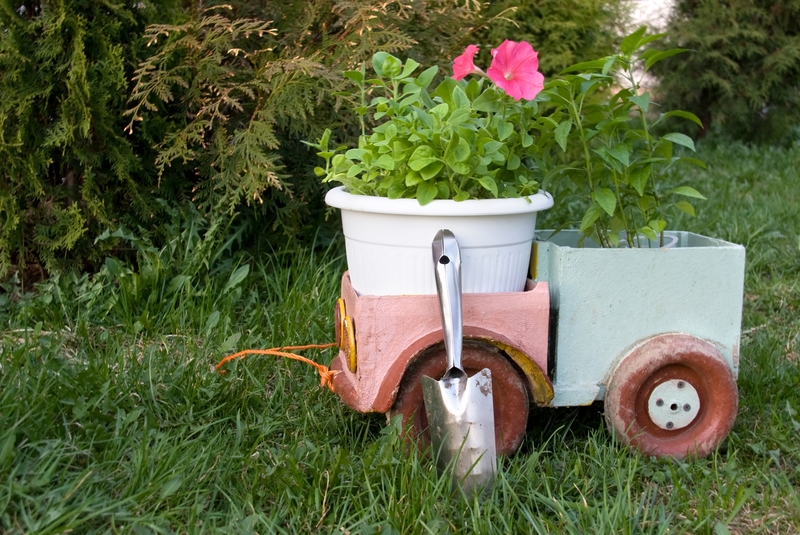Efficient Strategies for Plant Pot Disposal
When the gardening season winds down or when it's time to repot your beloved plants, many people face the often-overlooked question: What's the best way to dispose of plant pots? With environmental consciousness on the rise, efficient and responsible plant pot disposal strategies have become increasingly important. Whether you have a stockpile of plastic, clay, ceramic, or biodegradable pots, disposing of them thoughtfully can make a significant difference in your ecological footprint. Below, we'll explore comprehensive, eco-friendly, and effective methods for dealing with old or unused plant pots.

Understanding Different Types of Plant Pots
Before selecting the most suitable disposal option, it's crucial to identify the type of plant pots you have. The material makes a big difference in how you should handle their end-of-life process.
- Plastic Plant Pots: Lightweight, cost-effective, and common, but not always easy to recycle through curbside programs.
- Terracotta or Clay Pots: Porous, natural, and popular in gardens, these can be durable but also prone to breakage.
- Ceramic Pots: Often decorative, sometimes glazed, and can occasionally contain hazardous materials.
- Biodegradable Pots: Made from peat, coir, paper, or compostable fiber materials. Designed to break down in the environment.
Identifying the material helps you determine the most responsible plant pot disposal method for each type.
Eco-Friendly Disposal Options for Plastic Plant Pots
1. Reuse and Repurpose
- Reusing is the greenest choice. If the pots are still intact, consider keeping them for your next planting project or sharing with friends and neighbors.
- Creative Repurposing: Turn old pots into storage containers, organizers, seedling starts, or decorative pieces around your home and garden.
2. Return to Garden Centers and Nurseries
Many garden centers and horticultural retailers offer plant pot recycling programs. These programs might accept both plastic and other materials.
- Drop-off Programs: Contact local nurseries to check their policies before you bring your stash. Many chain stores now have dedicated collection bins for plastic pots and trays.
- Industry Recycling Partnerships: Some retailers partner with recycling companies that specifically handle horticultural plastics, ensuring pots are processed into new products.
3. Local Recycling Centers
Is curbside plastic recycling available in your area? Often, household recycling does not include the specific types of plastic used in plant pots, especially if they are #5 polypropylene or similar hard plastics.
- Check Recycling Codes: Most pots have a recycling code on the bottom. Visit your municipality's recycling guidelines to ensure they accept that type.
- Clean Thoroughly: Remove all soil and plant residue. Dirty pots can contaminate recycling streams.
- Special Collection Events: Certain communities hold annual events to collect plastics not accepted through regular pickup.
4. Donate to Community Gardens or Schools
Community projects, urban gardens, and schools often operate on tight budgets. Donating your empty pots helps reduce their expenses and supports local greening efforts.
- Reach out to school gardening clubs or local urban agriculture initiatives.
- Use local online groups (such as Freecycle or Facebook Marketplace) to offer pots for free pickup.
Disposing of Terracotta and Ceramic Plant Pots
1. Reuse and Decorative Repurposing
- Garden and Home Decor: Old terracotta pots can be painted, stacked into creative towers, or upcycled into whimsical crafts such as fairy gardens, candle holders, or mosaics.
- Crushed Pottery for Drainage: Broken clay or ceramic shards make excellent drainage material at the bottom of larger pots.
2. Curbside and Specialty Recycling
While most municipal programs don't accept ceramics or terracotta through the regular recycling stream, construction waste facilities or specialized recycling centers might.
- Check with local authorities or landfill operators for drop-off options for inert materials like brick and ceramic.
- Some pottery studios accept clean ceramic pieces for crushing and reuse in clay bodies.
3. Responsible Disposal as Landfill Material
If repurposing or recycling isn't possible, broken ceramics can be bagged and disposed of with regular trash, but this should be a last resort. Since terracotta and ceramics take thousands of years to decompose, always look for creative alternatives before trashing.
Composting and Biodegradable Plant Pots
Biodegradable plant pots are increasingly popular among eco-conscious gardeners. They break down naturally when exposed to moisture and microbes in soil.
1. Composting Biodegradable Pots
- Direct Planting: Many biodegradable pots are designed for direct transplantation--plant them in the ground, pot and all, so the material decomposes and feeds the soil.
- Home Composting: Break up larger or left-over biodegradable pots and add them to your compost pile or bin. They'll integrate with other organic matter over time.
2. Municipal Green Waste Pick-Up
- Some municipalities accept compostable pots as part of green waste collection. Check your city's composting rules for specifics.
How to Clean and Prepare Plant Pots for Disposal
Before you recycle, donate, or reuse your pots, it's important to prepare them properly:
- Empty out all soil and plant residue. Shake out excess dirt and rinse with water.
- Sanitize with diluted bleach or vinegar. This step is crucial to prevent the spread of pests and diseases to new plantings if the pot is being reused or donated.
- Allow to dry thoroughly before packing for transport, recycling, or storage.
Creative Upcycling Ideas for Old Plant Pots
When it comes to sustainable plant pot disposal, upcycling gives you the best of both worlds: waste reduction and unique, personalized garden or home accessories.
- Vertical Gardens: Attach small pots to a pallet or wall to create a living wall of herbs or succulents.
- Pot Sculptures: Stack and glue old pots into statues or decorative towers for garden art.
- Bird baths and Feeders: Use shallow, wide ceramic pots to help attract birdlife to your yard.
- Storage Solutions: Use larger pots for storing gardening tools, hoses, or outdoor toys.
Best Sustainability Practices and Zero Waste Tips
1. Choose Recyclable or Compostable Pots at Purchase
Whenever possible, buy plants from nurseries that offer eco-friendly packaging. Avoid black plastics (less frequently recycled) and look out for the recycling codes.
2. Prioritize Longevity and Reuse
- Invest in sturdy pots that can be reused for years, reducing your overall waste.
- Store unused pots in a dry place to extend their lifespan.
3. Community Sharing and Swap Events
- Start a "pot swap" event in your gardening club or neighborhood.
- Share surplus pots at community events, seed swaps, or local farmer's markets.
Common Mistakes to Avoid When Disposing of Plant Pots
- Blending plastic pots with household recycling without checking codes - this can contaminate your recyclables.
- Throwing pots straight into landfill when better options exist.
- Ineffective cleaning of pots before recycling or donation, risking the spread of plant diseases.

Frequently Asked Questions About Plant Pot Disposal
Can plastic plant pots be recycled curbside?
Not always. Most curbside programs do not accept the rigid plastics used for garden pots. Check your local guidelines or look for specialized collection programs at garden centers.
Are biodegradable pots truly compostable?
Yes, but compostability depends on the material. Fiber, peat, and coir pots break down easily in home compost or garden soil. Glued, painted, or treated pots may need municipal composting facilities.
What can I do with broken plant pots?
Broken terracotta and ceramic pieces can be repurposed for drainage, mosaic art, or added to walkways. Plastic shards, however, must be handled carefully and not left in the garden.
Conclusion: The Future of Sustainable Plant Pot Disposal
Efficient plant pot disposal is about choosing the most environmentally responsible option--be it recycling, repurposing, donating, or composting. By understanding the materials your pots are made from and staying informed on local recycling practices, you can dramatically reduce the impact of your gardening hobby. As sustainability becomes central to gardening culture, manufacturers and consumers alike are embracing more eco-friendly, reusable, and compostable containers.
Make every pot count by choosing the absolute best disposal strategy. With a little creativity and diligence, gardeners can help build a greener planet--one pot at a time.